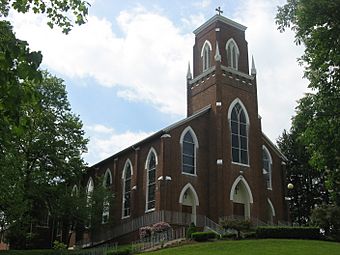Saint Joseph's Catholic Church (Somerset, Ohio) facts for kids
Quick facts for kids |
|
|
Saint Joseph's Catholic Church
|
|
 |
|
| Nearest city | Somerset, Ohio |
|---|---|
| Area | 7.6 acres (3.1 ha) |
| Built | 1843 |
| Architect | Thomas Spare |
| Architectural style | Gothic, High Victorian Revival |
| NRHP reference No. | 86002267 |
| Added to NRHP | August 7, 1986 |
Saint Joseph's Catholic Church is a very old and important church located in Somerset, Ohio. It belongs to the Roman Catholic Diocese of Columbus. This church is special because it's one of the oldest Catholic church buildings in Ohio. It is also home to Ohio's oldest Catholic parish, which is a local church community. Priests from the Dominican order have served this parish since it began. The church building was finished in 1843. In 1986, it was added to the National Register of Historic Places, which lists important historical sites.
Contents
The Church's Story
Early Beginnings in Ohio
Around 1798, a German-Catholic pioneer named Jacob Dittoe moved to the wild lands of Ohio. This was near where Somerset is today. About seven years later, Dittoe started asking Bishop Carroll of Baltimore for help. Bishop Carroll was the only Catholic bishop in the United States at that time. Dittoe wanted priests to come and serve his growing Catholic community.
On February 1, 1808, Dittoe wrote to the bishop. He explained that the local people needed the Sacraments, which are important religious ceremonies. He also asked if a Catholic lawyer could make marriages official if no priest was available. This letter seemed to make the bishop act. He sent a Dominican priest named Father Edward Fenwick from Kentucky. Father Fenwick's job was to find Dittoe and help his community with their religious needs.
Father Fenwick's Journey
Father Fenwick traveled from Kentucky to Ohio along a path called Zane's Trace. When he reached New Lancaster, he learned where Dittoe lived. The road was hard to follow, so Father Fenwick listened for the sound of an ax chopping wood. This led him to the home of Jacob and Catherine Dittoe in September 1808. From that time on, Father Fenwick tried to visit the community every year.
One special visit happened in 1812. Bishop Flaget of Bardstown and Father Stephen Badin stayed with the Dittoes while traveling to Baltimore. Bishop Flaget wrote about this visit. He said they stayed with Mr. Dittoe, who was a good Catholic and ran an inn.
A Place for Worship
Bishop Flaget wrote that Jacob Dittoe and his brother had bought 320 acres of land. This land was meant for a priest to live on. Dittoe had already built a small house and cleared ten acres of land. Bishop Flaget promised to try and send a priest at least once a year. He also told Mr. Dittoe to build a house that could be both a home for the priest and a chapel. A chapel is a small church.
This chapel would be a place where Catholics could gather every Sunday. It would help them feel closer to each other and remember their duties as Catholics. Bishop Flaget believed the Catholics in the area were numerous enough to form a "respectable congregation." He also noted that the German people loved music. He thought church services would be beautiful and dignified there. He was very happy that all of Mr. Dittoe's children were musicians. He ended his thoughts by wishing for more priests.
The First Church Buildings
The 320 acres of land Bishop Flaget mentioned were eventually given to Father Fenwick. It was meant to be a place for a church and a seminary, which is a school for training priests. In 1816, Bishop Flaget assigned Father Fenwick to Ohio full-time. He became a traveling missionary.
In 1818, Father Fenwick and his nephew, Father Nicholas Dominic Young, moved into a cabin Dittoe built. This cabin became the main office for the Catholic missions in Ohio. Father Fenwick officially opened the first Saint Joseph Church on December 6, 1818. It was a log building, 22 feet long and 15 feet wide. This was the very first Catholic church building in Ohio. Jacob Dittoe chose Saint Joseph as the church's special patron saint. The first baptism recorded at the new church was for Nicholas J. Ryan on December 24, 1818. Winters in the log church were very cold. A special heater called a brazier was used on the altar during Mass to keep the Communion wine from freezing.
New Buildings and Changes
Father Fenwick left St. Joseph Church in 1821. He was chosen to be the bishop of the new Diocese of Cincinnati. Father Young continued the work alone until 1823. Then, Father Daniel O'Leary joined him at St. Joseph and stayed until the mid-1830s.
During that time, the log church was replaced with a brick one. This new brick church was officially opened on January 11, 1829. Over time, this building also became too small. So, construction on another church building began in 1839. Even though there were money problems, the church was finished and opened in 1843. This is the same St. Joseph church building that stands today. In 1864, a fire destroyed everything inside the church except for the walls. But the church was rebuilt. The inside of the church was updated in 2016.
Important Clergy Members
Some important priests and bishops served at Saint Joseph's Catholic Church:
| Important Clergyman | Role / Position |
|---|---|
| Edward Dominic Fenwick | Bishop of Cincinnati (1822 - 1832) |
| Joseph Sadoc Alemany | Bishop of Monterey (1850 - 1853), Archbishop of San Francisco (1853 - 1884) |
Today at Saint Joseph's
Today, St. Joseph's shares a pastor with another church, Holy Trinity, which is also in Somerset.
Images for kids






